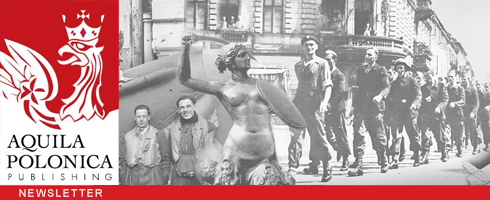September 29-30, 1944 – The Warsaw Uprising, Part 7
 We are ending our series of blog posts about the Warsaw Uprising — which has drawn from our award-winning book The Color of Courage, by Julian Kulski — with this post describing Kulski’s last battle, the order to surrender, and the march into captivity.
We are ending our series of blog posts about the Warsaw Uprising — which has drawn from our award-winning book The Color of Courage, by Julian Kulski — with this post describing Kulski’s last battle, the order to surrender, and the march into captivity.
Kulski spent the next seven months as a prisoner of war in Stalag XI-A, before finally risking a dash for freedom onto an American truck in early May 1945 as the war was ending, instead of waiting for “liberation” by the Soviets.
CHAPTER 6
AGE 15: 1944 — THE WARSAW UPRISING
pp. 335–337:
Friday, September 29 — The Germans are now advancing at a terrific speed. This evening they took over Saint Stanisław Kostka Church and gained ground along one side of Krasiński Street. From a window in our cellar, we could easily see the tanks rolling along the boulevard. Then, after taking positions in front of the apartment house we were holding, they began to destroy it methodically.
Because the enemy was so very near, we decided it would be better to rejoin our company, so we left the cellar under cover of darkness, crawling away over the sharp rubble on hands and knees.

I noticed that I was not cold anymore. The whole of Żoliborz was on fire, and the flames illuminated the streets, warming the air around us.
All this time, the Red Army waited in silence in Praga, on the opposite side of the Vistula River, promising every day to send help and telling us to keep on fighting. Not a single company crossed the river.

Then the Germans attacked with full-size tanks as well as Goliats [small robot tanks]. All communication between our units broke down, and each detachment was now completely on its own. By late afternoon, the Germans had driven deeply into the southern section of Żoliborz, toward Wilson Square and Krasiński Street. The artillery fire ceased only when night fell.
This evening we heard that General Bór-Komorowski had notified London that our situation is desperate, and that capitulation is inevitable unless large quantities of arms are received at once.
At the same time, he sent a message to Colonel ‘Żywiciel’ to keep on fighting, if only for one more day.
During the night, I joined my friends, and helped them to defend our building against strong attacks by the enemy. I stood behind the window in the cellar bunker, so weak that I was hardly able to stand on my feet—let along to continue firing—but now and then I would climb the ruins of the staircase and throw grenades upon the attacking Germans.
pp. 342–344:
Saturday, September 30 — Night — The news came through, striking like lightning. The message was starkly brief. Surrender! The word itself brought forth a furious barrage of oaths from all sides: “Lies!” “Impossible!” Still, all the companies were ordered to line up. We did so, not yet able to believe what was happening.
Lieutenant ‘Szeliga’ stood before our company. I had to struggle to stand to attention and to concentrate as he took a paper from his breast pocket and began to read aloud the order from Colonel ‘Żywiciel’:
Soldiers!
I thank you, my dear comrades, for everything you have accomplished during these two months of fighting with the enemy, for your efforts, pain, and courage.
I am proud that I had the honor to command such soldiers as you.
Remain such in the future and show the world what a Polish soldier is, he who will sacrifice everything for his country.
Soldiers!
An hour ago, as ordered by the Supreme Commander of the Armed Forces, General Bór-Komorowski, I signed the surrender document of our group…
We are surrendering to the Wehrmacht as a regular army, and we will be treated according to the Geneva Convention.
I thank you once more for everything.
God be with you!
Saturday, September 30 — Midnight — After that, everything went like a nightmarish dream. Hardly realizing it, we began to fall into military formation. It was nearly midnight as we started our slow march uphill from the Glass House along Mickiewicz Street toward Wilson Square.
We all made one last effort and marched in an even measured step, as on parade, our rifles on our shoulders. We had to remind the Germans what kind of soldiers they had been fighting during the last two months.

With officers at our flanks, we advanced toward Wilson Square, solidly lined with tanks, where the Germans were waiting for us. When we were about thirty feet from a gate leading into the courtyard of a large building, the command came: “Kompania stój!” (Company halt!). Our commander exchanged words in German with the officer in charge. Then we entered the courtyard.
A thrill of terror shook me as I saw the faces and uniforms of the hated enemy at such close range. The Germans at once surrounded us and confiscated our short arms, field glasses, and so on. Then we marched in company formation through the courtyard; passing the tanks standing at the entrance to Słowacki Street, we found ourselves in the middle of Wilson Square, illuminated by the flames of burning Żoliborz. Here, we had to lay down the rest of our weapons.
I had nothing left to give up.


No comment yet, add your voice below!